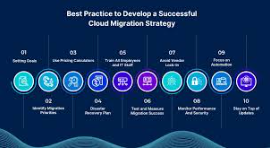Cloud computing is no longer a futuristic concept—it’s the foundation of modern business innovation. From enhancing scalability and agility to reducing infrastructure costs, the cloud offers transformative benefits for organizations of all sizes. However, making the shift isn’t as simple as flipping a switch. Companies must adopt well-structured cloud migration strategies to ensure a smooth, secure, and cost-effective transition.
This article explores the top cloud migration strategies, helping you understand when and how to apply them, along with real-world insights and best practices for success.
Why Cloud Migration Matters
Migrating to the cloud is more than a technology shift—it’s a strategic move that impacts business operations, security, and long-term growth. According to Gartner, worldwide spending on public cloud services is projected to exceed $679 billion by 2024, highlighting how critical cloud adoption has become for competitiveness.
Key benefits of cloud migration include:
- Cost efficiency: Pay-as-you-go pricing reduces capital expenditures.
- Scalability: Easily handle fluctuating workloads and seasonal demands.
- Security & compliance: Leverage advanced cloud security frameworks.
- Innovation: Access to AI, analytics, and automation tools.
To reap these benefits, organizations need the right strategy tailored to their business goals and workloads.
The 6 Rs of Cloud Migration
One of the most widely adopted frameworks for migration strategies is the “6 Rs” model, which outlines six distinct approaches. Let’s break them down:
1. Rehosting (Lift and Shift)
- Definition: Moving applications directly to the cloud without modification.
- When to use: Best for organizations looking for a quick, cost-effective migration with minimal disruptions.
- Pros: Fast, low risk, and less complex.
- Cons: May not leverage full cloud-native benefits.
2. Replatforming (Lift, Tinker, and Shift)
- Definition: Making small adjustments to optimize workloads for the cloud without full re-architecture.
- Example: Switching from self-managed databases to cloud-managed services.
- Pros: Better performance, cost savings, and improved scalability.
- Cons: Requires more effort than rehosting.
3. Repurchasing
- Definition: Moving to a completely new cloud-native application, often SaaS.
- Example: Migrating from an on-premise CRM to Salesforce or HubSpot.
- Pros: Immediate access to modern features and reduced management burden.
- Cons: May involve retraining staff and data migration challenges.
4. Refactoring (Re-architecting)
- Definition: Redesigning applications to leverage cloud-native features like microservices, containers, or serverless computing.
- When to use: For mission-critical workloads requiring high performance, scalability, or modernization.
- Pros: Maximizes cloud value, enables innovation, and supports long-term growth.
- Cons: Time-consuming and resource-intensive.
5. Retiring
- Definition: Decommissioning outdated or redundant applications instead of migrating them.
- Pros: Cost savings, reduced complexity.
- Cons: Requires careful evaluation to avoid losing essential data or functionality.
6. Retaining (Revisit)
- Definition: Keeping certain workloads on-premises or delaying migration due to compliance, cost, or complexity.
- Pros: Avoids unnecessary risk for sensitive workloads.
- Cons: Limits full adoption of cloud benefits.
Choosing the Right Strategy
Selecting the best strategy depends on your organization’s needs, technical capabilities, and business objectives. Consider the following factors:
- Application complexity: Legacy systems may need refactoring, while simple workloads can be rehosted.
- Business goals: Is the focus on cost savings, innovation, or speed?
- Compliance requirements: Highly regulated industries may need hybrid or multi-cloud approaches.
- Skill availability: Do you have the in-house expertise to manage modernization?
Best Practices for Cloud Migration Success
No matter which strategy you choose, success depends on careful planning and execution. Here are some proven best practices:
- Conduct a cloud readiness assessment
- Identify workloads, dependencies, and risks.
- Evaluate application performance and compliance needs.
- Choose the right cloud provider
- Compare AWS, Microsoft Azure, and Google Cloud based on services, pricing, and regional availability.
- Read our detailed guide on how to choose a cloud provider.
- Prioritize security and compliance
- Implement encryption, IAM (Identity Access Management), and monitoring.
- Reference trusted resources like NIST Cloud Security Guidelines.
- Adopt a phased migration approach
- Start small with non-critical workloads before migrating mission-critical applications.
- Train your workforce
- Upskill employees on cloud tools and services to ensure smooth adoption.
- Monitor and optimize continuously
- Use cloud monitoring tools for performance tracking and cost optimization.
- Check our article on best cloud monitoring software.
Common Challenges in Cloud Migration
Despite the advantages, organizations often face hurdles such as:
- Downtime risks: Poor planning can disrupt operations.
- Cost overruns: Unexpected expenses from under-optimized resources.
- Skill gaps: Lack of in-house expertise in managing cloud environments.
- Vendor lock-in: Over-reliance on one provider can limit flexibility.
Mitigating these challenges requires proactive planning, strong governance, and a hybrid or multi-cloud approach where necessary.

Conclusion
Cloud migration is a transformative journey that can redefine how your business operates, innovates, and grows. By carefully selecting from the top cloud migration strategies—whether it’s rehosting, refactoring, or repurchasing—you can align your cloud adoption plan with long-term business goals.
Success lies in preparation, choosing the right provider, and continuously optimizing cloud environments. With the right strategy, your organization won’t just move to the cloud—it will thrive in it.
Looking to scale your business with cloud technologies? Check out our in-depth guide on how to scale business using cloud for actionable insights.
